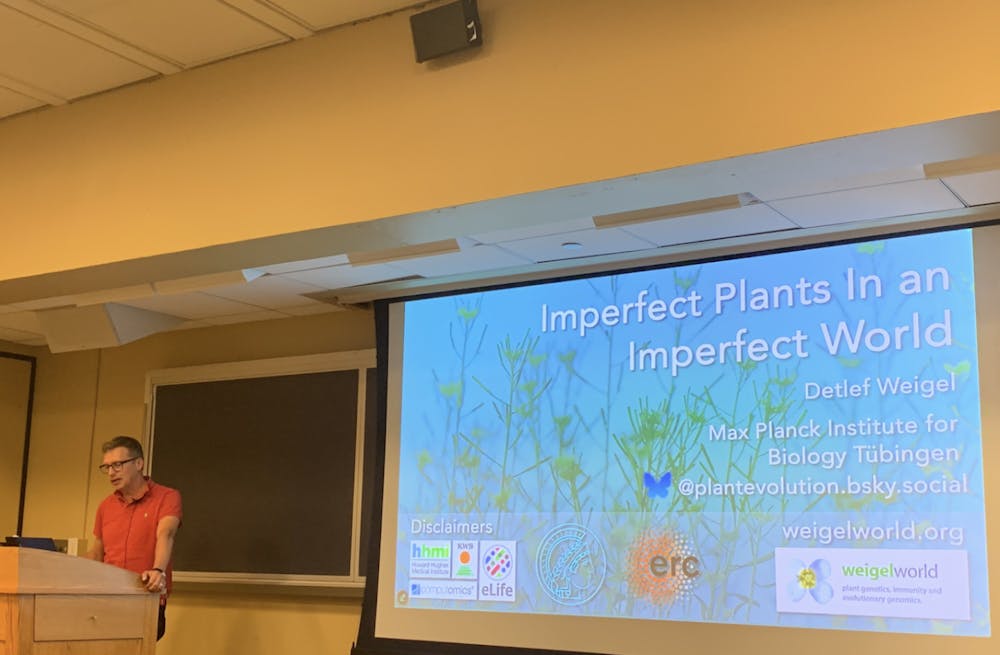The Department of Biology hosted Detlef Weigel, director at the Max Planck Institute for Biology Tübingen and member of the National Academy of Sciences, on Friday, Oct. 25. Weigel gave a talk titled "Imperfect plants in an imperfect world,” which explored his research group’s work on genetic variation in the model organism Arabidopsis thaliana.
Weigel first explained that mutations are often depicted in a negative light. For instance, when particular genes get mutated, cells can translate dysfunctional proteins, giving rise to notable conditions like sickle cell disease and cystic fibrosis that affect millions of people worldwide.
“When we think of human diseases, we think of mutations that have broken things and therefore cause disease,” Weigel said. “But the truth is that many of the mutations that cause disease were originally positively selected for because they were advantageous at a different time and in different situations. The bottom line is that context matters a lot in genetics, and evolutionary geneticists have come up with a whole slew of different terms that refer to this fact.”
One particular term — antagonistic pleiotropy — describes a situation in which a specific variant of a gene has multiple opposing effects on an organism’s fitness. For example, an allele that makes plants flower prematurely may be disadvantageous for the plant’s water-use efficiency because the flowers require excess water to grow and survive. However, that same trait may be advantageous in drought conditions because earlier flower production leads to earlier pollination and fruiting, allowing the plant to produce seeds more quickly than others.
In Weigel’s case, he and other scientists observed a particular mutation in an Arabidopsis gene known as ACCELERATED CELL DEATH 6 (ACD6) that led to decreased size and leaf necrosis, which, at first, seem like two traits that decrease plant fitness. But Weigel soon realized that those plants with the ACD6 mutation exhibited stronger immune responses than wild-type plants and that the leaf necrosis was due to the plant’s hyperactive immune activity against its own tissues.
“It turned out that we had merely rediscovered a phenomenon... called hybrid necrosis,” Weigel explained. “Interestingly, we were the first ones who actually thought that this was related to autoimmunity. It was very clear in the previous literature, but people didn't realize that we could get an immune response against a pathogen just because of genetic constitution.”
After discovering and characterizing this hybrid necrosis phenotype in the lab, Weigel expanded his research to the field.
“Since we wanted to understand the evolution of the immune system, we had to go into the wild,” Weigel stated. “We started the ‘pathogen and Arabidopsis’ collection in 2018, and, in a pretty short amount of time, we collected almost 300 populations all across Europe.”
Weigel’s group not only collected and analyzed the plant genotypes but also analyzed the plants’ corresponding microbiomes. Intriguingly, they found that Arabidopsis microbiomes tend to be geographically clustered, with one cluster in Northern Europe and one in Southern Europe. When they investigated the factors contributing to this geographic clustering, they found that the drought severity of a given region (according to the Palmer Drought Severity Index) was the metric that best explained their microbiome data.
When Weigel looked at immune gene expression between the two clusters of Arabidopsis and their microbiomes using a genome-wide association study approach, he found that the most differentially expressed gene was ACD6, the same hybrid necrosis gene they had found in the lab.
To test the biological relevance of this particular mutation, Weigel’s team produced ACD6 genetic knockouts and grew them in both greenhouse and field conditions. When Arabidopsis plants were grown in the greenhouse under comfortable temperature and humidity conditions, the ACD6 knockout plants continued to show the hybrid necrosis phenotype with a significantly smaller body and a significant portion of necrotic leaves. However, when they grew ACD6 and wild-type plants in the wild, Weigel’s group encountered an unexpected result.
“All the differences disappeared at the morphological level,” Weigel said. “Growing ACD6 present or knockout plants had no differentially expressed genes and had no obvious effect on the microbiome.”
Weigel hypothesizes that this unexpected phenomenon is due to the increased complexity that comes with wild plant growth as opposed to growth in controlled laboratory conditions.
“Laboratory genetics can be simple, but please don’t be fooled — real-life ecology is anything but,” Weigel explained. “And that’s why my favorite quote is: Nothing in evolution makes sense except in the light of ecology.”





